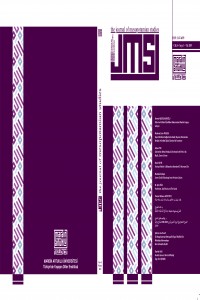The Theory of Teaching and Use of Reading in Kurdish
Öz
As
known, all over the world the Ss can obtain a systematic and methodological
approach through reading. Unfortunately, in most of the Middle Eastern
countries, the reading level and habit is very low. The situation mentioned is
totally similar in Kurdish spoken cities as well and this ratio tends to differ
in many cities. In order to obtain a very successful reading level, the reading
strategies should be carried out properly, a systematic reading order should be
followed and every time the evaluation period should be checked on a regular
basis. As Kurdish Education faculties
don not exist, it is an imperative that some organizations should be
established to lay the foundation of teaching methodology and criteria in terms
of reading. Moreover, authentic materials should be prepared and adapted in
accordance with the level.
Kaynakça
- Baker, L., û Wigfield, A. (1999). “Dimensions of Children’s Motivation for Reading and Their Relations to Reading Activity and Reading Achievement”. Kovara Reading Research Quarterlyê, hej. 34.
- Chung, X., & Nation, I. S. P. (2003). “Technical Vocabulary in Specialised Texts”. Reading in a Foreign Language, Hej.15, 103–116.
- Clay, M. M. (2002). An Observation Survey of Early Literacy Achievement. Portsmouth: Weşanên Heinemannê. Davis, F. (1944). Fundamental Factors of Comprehension in Reading. Weşanên Psychometrika, 9, 185–197.
- Demirel, Ö., (1999) Yabancı Dil Öğretimi, Stenbol: Weşanên MEBê.
- Grabe, W., & Stoller, F. (2002). Teaching and Research Reading. Harlow, UK: Longman.
- Grellet. F., (1981). Developing Reading Skills. Cambridge: Weşanên Cambridgeê.
- Hedge, T., (2000), Teaching and Learning in the Classroom, Oxford: Weşanên Zanîngeha Oxfordê.
- Hyland, K. (2002) Teaching and Researching Writing, New York, Weşanên Longmanê.
- Krashen, S.D., (2001). Do Teenagers Like to Read? Yes! USA: Weşanên Reading Today.
- Krashen, S. D., (2004), The Power of Reading: Insights from the Research. Weşanên Libraries Unlimitedê, Çapa Duduyan, Connecticut and London
- Laufer, B., & Sim, D. (1985). “Measuring and Explaining the Reading Threshold Needed for English for Academic Purposes Texts”. Foreign Language Annals, hej.18, 405–411.
- McDonough, Jo & Christopher, S., (2003), “Materials and Methods in ELT: A Teacher’s Guide”, New Jersey: Weşanên Blackwell Publishingê,.
- McKenna, M.C. and Stahl, K. A. D. (2009) Assessment for Reading Instruction (çapa duduya.). New York: Weşanên Guilfordê.
- Nation, P. & J. Coady. (1988) “Vocabulary in Reading” di edt. R.Carter & m. McCarthy. r. 97 – 110
- Pardo, L. (2004). “What Every Teacher Needs to Know About Comprehension”. Di kovara The Reading Teacher. 272-281.
- Weaver, C., (2009). Reading Process. Portsmouth NH: Weşanên Heinemann.
- Ur, P., (1996), “A Course in Language Teaching: Practice and Theory”, Cambridge: Weşanên Zanîngeha Cambridgeê.
Teoriya Hînkirin û Bikaranîna Xwendinê Di Kurmancî De
Öz
Wekî
tê zanîn, li hemû dinyayê mirov hînbûneke sîstematîk û metodolojîk bi saya
xwendinê pêk tîne. Li gelek welatên Rojhilata Navîn mixabin asta xwendinê zehf
kêm e. Ev rewş li bajarên kurdan jî heman rewş e û li gelek deveran asta
xwendinê ji astên gelek welatan kêmtir e. Ji bona xwendinek ku bigihîje
armanceke baş divê stratejîyên xwendinê baş bên pêkanîn, xwendineke bi sîstem
hebe, û di hinek pêvajoyan de rewşa xwendekaran ast bi ast bê nirxandin. Ji ber
ku fakulteyên perwerdehîyê ji bona
hînkirina Kurmancî tune ne, pêwîst e sazî bikaribin li ser metodolojîyê
bisekinin û krîteran dîyar bikin. Di ser re divê materyalên xwendinê li gorî
armancên cûda bên amadekirin û bên adaptekirin.
Kaynakça
- Baker, L., û Wigfield, A. (1999). “Dimensions of Children’s Motivation for Reading and Their Relations to Reading Activity and Reading Achievement”. Kovara Reading Research Quarterlyê, hej. 34.
- Chung, X., & Nation, I. S. P. (2003). “Technical Vocabulary in Specialised Texts”. Reading in a Foreign Language, Hej.15, 103–116.
- Clay, M. M. (2002). An Observation Survey of Early Literacy Achievement. Portsmouth: Weşanên Heinemannê. Davis, F. (1944). Fundamental Factors of Comprehension in Reading. Weşanên Psychometrika, 9, 185–197.
- Demirel, Ö., (1999) Yabancı Dil Öğretimi, Stenbol: Weşanên MEBê.
- Grabe, W., & Stoller, F. (2002). Teaching and Research Reading. Harlow, UK: Longman.
- Grellet. F., (1981). Developing Reading Skills. Cambridge: Weşanên Cambridgeê.
- Hedge, T., (2000), Teaching and Learning in the Classroom, Oxford: Weşanên Zanîngeha Oxfordê.
- Hyland, K. (2002) Teaching and Researching Writing, New York, Weşanên Longmanê.
- Krashen, S.D., (2001). Do Teenagers Like to Read? Yes! USA: Weşanên Reading Today.
- Krashen, S. D., (2004), The Power of Reading: Insights from the Research. Weşanên Libraries Unlimitedê, Çapa Duduyan, Connecticut and London
- Laufer, B., & Sim, D. (1985). “Measuring and Explaining the Reading Threshold Needed for English for Academic Purposes Texts”. Foreign Language Annals, hej.18, 405–411.
- McDonough, Jo & Christopher, S., (2003), “Materials and Methods in ELT: A Teacher’s Guide”, New Jersey: Weşanên Blackwell Publishingê,.
- McKenna, M.C. and Stahl, K. A. D. (2009) Assessment for Reading Instruction (çapa duduya.). New York: Weşanên Guilfordê.
- Nation, P. & J. Coady. (1988) “Vocabulary in Reading” di edt. R.Carter & m. McCarthy. r. 97 – 110
- Pardo, L. (2004). “What Every Teacher Needs to Know About Comprehension”. Di kovara The Reading Teacher. 272-281.
- Weaver, C., (2009). Reading Process. Portsmouth NH: Weşanên Heinemann.
- Ur, P., (1996), “A Course in Language Teaching: Practice and Theory”, Cambridge: Weşanên Zanîngeha Cambridgeê.
Ayrıntılar
| Birincil Dil | Türkçe |
|---|---|
| Konular | Dilbilim |
| Bölüm | Makaleler |
| Yazarlar | |
| Yayımlanma Tarihi | 21 Şubat 2019 |
| Gönderilme Tarihi | 26 Aralık 2018 |
| Yayımlandığı Sayı | Yıl 2019 Cilt: 4 Sayı: 1 |
The Journal of Mesopotamian Studies (JMS) Creative Commons Atıf-GayriTicari 4.0 Uluslararası ile lisanslanmıştır.

